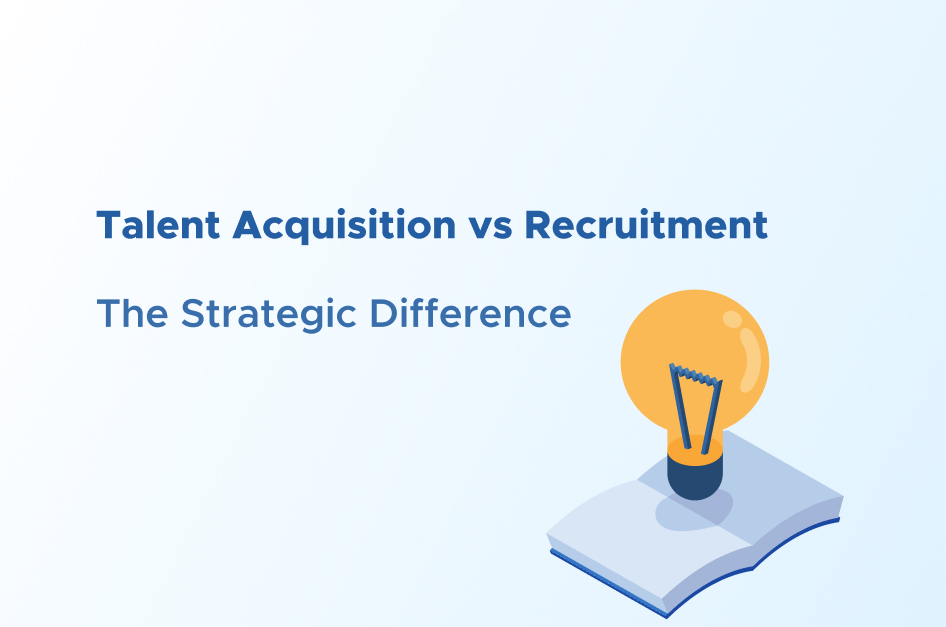Talent Acquisition vs Recruitment: The Strategic Difference Every Organization Should Understand
Recruitment fills roles. Talent acquisition builds capability. Understand how forward-thinking organizations use long-term strategies to attract, retain, and develop top talent.

IIn today’s world of work, where adaptability, innovation, and agility define organizational success, attracting and retaining the right people has become a strategic priority.
Talent is no longer viewed as a supporting function it is the driving force behind growth, transformation, and resilience.
Yet, many organizations continue to treat talent acquisition and recruitment as interchangeable. While they share a common goal of bringing people into an organization, their approaches, objectives, and long-term impact differ in profound ways.
Recruitment focuses on the present. It is designed to fill vacancies quickly, ensuring operational continuity.
Talent acquisition, however, looks ahead. It builds a sustainable framework that aligns workforce capabilities with the organization’s long-term goals, anticipating future skills and leadership requirements.
Understanding the distinction between the two is not just a matter of terminology it defines how organizations build their workforce, shape their culture, and secure their future.
Talent Acquisition vs Recruitment: A Closer Look
Talent acquisition extends beyond immediate hiring needs. It involves building relationships with potential candidates, creating awareness of the organization’s brand, and maintaining a continuous presence in the talent market
Recruitment, by contrast, is driven by urgency it begins when a position opens and ends when it is filled.
Both processes are vital, but companies that rely only on recruitment often find themselves repeating hiring cycles, struggling with turnover, and missing opportunities to shape their future workforce.
Why Strategic Talent Acquisition Creates Value
- Predicts Future Needs
Talent acquisition integrates with business forecasting, helping leaders plan for future capabilities instead of reacting to short-term gaps. - Improves Quality and Retention
By focusing on cultural alignment and long-term fit, organizations achieve stronger engagement and lower turnover. - Strengthens Employer Branding
A proactive acquisition strategy positions the organization as an employer of choice, a critical differentiator in competitive markets. - Enhances Diversity and Innovation
Broader sourcing strategies and sustained pipelines bring a wider range of skills and perspectives into the business. - Reduces Time to Hire and Long-Term Costs
Although the initial investment may be higher, structured pipelines reduce repetitive costs and shorten hiring timelines over time.
Global Perspective: Trends Shaping Talent Strategies
Organizations around the world are rethinking how they attract, engage, and retain talent.
Evolving workforce expectations, digital transformation, and shifting skill requirements are reshaping the future of hiring and development.
The most forward-thinking organizations today are focusing on five key areas that define modern talent strategies:
- Data-driven workforce planning: Using analytics to forecast skill gaps and future talent demand.
- Skills-first hiring: Moving beyond job titles to assess capability and potential.
- AI and automation in sourcing: Streamlining screening and candidate communication.
- Enhanced candidate experience: Personalizing touchpoints and strengthening employer storytelling.
- Internal mobility and upskilling: Prioritizing development and redeployment over external hiring.
Forward-thinking companies understand that acquisition is a continuous process that blends technology, data, and human connection.
The GCC Context
While these global shifts apply everywhere, the GCC region presents unique dynamics.
Rapid diversification, nationalization programs, and ambitious Vision 2030 goals are transforming the workforce landscape.
Organizations across Saudi Arabia, the UAE, Kuwait, and Qatar areadopting acquisition models that combine immediate recruitment efficiency withlong-term strategic planning.
This evolution is driven by:
- Growing competition for specialized talent in technology, sustainability, and innovation.
- Localization mandates that require structured and compliant workforce strategies.
- A stronger focus on employer branding as professionals compare opportunities regionally and globally.
Companies that invest in sustainable acquisition strategies are betterpositioned to meet these regional demands while building resilient, diverseteams.
How Procapita Group Talent Supports Organizations
At Procapita Group Talent, we partner with organizations totransform hiring from a short-term process into a long-term strategy.
Our approach combines market intelligence, analytics, and strategic insight todeliver:
- Workforce planning and leadership succession frameworks
- Market mapping and talent pipeline development
- Employer branding and candidate engagement programs
- Nationalization-aligned sourcing strategies
- Executive search and critical role acquisition
With a footprint across the GCC and a perspective shaped by global HRpractices, Procapita Talent helps clients build not just teams, but lastingorganizational capability.
Final Thought
Recruitment fills roles.
Talent acquisition builds resilience.
In a business environment defined by uncertainty and transformation, thedifference between the two can determine whether an organization simply growsor truly evolves.

